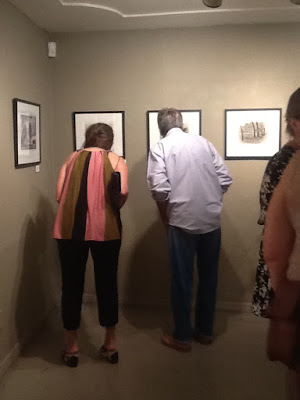 |
| Viewers enjoy a selection of Lincoln Draper's single-plate gravure prints. |
On July 3, New Grounds Print Workshop & Gallery hosted a First Friday reception, which featured a great new exhibition of gravure prints by Lincoln Draper, Fransisco Valenzuela and Jessica Weybright.
The exhibition, Explorations in Gravure - 19th Century Aesthetic, 21st Century Technology, runs through July 31.
The exhibition, Explorations in Gravure - 19th Century Aesthetic, 21st Century Technology, runs through July 31.
 |
| Works by Jessica Weybright (L) and Fransisco Valenzuela (R) |
In
this particular exhibition, we juxtapose various approaches to gravure, centered
on landscape. Our three artists are examples of single plate, duo tone and full
color gravure.
Lincoln
Draper evokes the many moods and feelings of New Mexico through rich,
traditional black and white imagery. His single-plate approach references a
classic 19th century aesthetic.
 |
| Lincoln Draper with one of his prints, contemplating my iPad photography 'skills.' |
 |
| More of the crowd enjoying Lincoln's work (that's Jessica Weybright, too!) |
Lincoln also gave a single-plate gravure demo. You can expect the demo video soon!
He demonstrated inking, wiping and printing one of the pieces featured in the exhibition.
He demonstrated inking, wiping and printing one of the pieces featured in the exhibition.
 |
| Lincoln Draper's demo station |
 |
| Lincoln Draper's Narrow Crossing |
Fransisco Valenzuela uses the
principle of duo tone by printing two plates, almost alike, and almost in the
same hue, with the first one light and the second plate saturated. The result
is a richer finality than printing the same plate once, bringing his world to
life.
 |
| Fransisco Valenzula's San Lorenzo de Picuris |
Jessica Weybright’s colorful, layered multi-plate works document a romantic vision of her travels through Asia. Using multiple plates gives Weybright’s work a vibrant sense of transparency and movement.
It is
important to understand that gravure is not a means of reproducing existing
photographs or drawings. Photographs that
will become the base for the photo etching usually need to be shot and
developed differently than for photographic prints. The advantage of photo
etching is its flexibility, which allows artists from varied backgrounds such
as photography, computer graphics, and drawing to create hand printed limited
editions. There is no limit to color, plates can be wiped in any one ink,
several plates can be printed on top of each other, subtle shading can be
achieved with selective wiping or chine collé, and gravure can be combined with
any other printmaking techniques. The limit is the artist’s imagination.
 |
| Hong Kong Love Song II - Jessica Weybright |
While
in photography a negative is exposed
directly to light-sensitive paper, in photogravure
the image is exposed to a light-sensitive plate from which the image is then
hand-printed on paper using an etching press. It is this particular detail that
places gravure into the realm of printmaking.
Photogravure – which precedes
photography - was revived in the mid-90s with the introduction of safer,
light-sensitive polymer films and plates adapted from the circuit board
industry. The image is generated by exposing a photo positive to a photo polymer plate via a high powered light.
Usually, artists need to do extensive testing to determine the exact exposing
time for each image. The exposed plate is developed in water and can be printed
almost immediately.
 |
| Viewers enjoy the work of Lincoln Draper |
 |
| Tanya Landin and Jessica Weybright |
Want to learn gravure yourself? We offer classes!
Miss the opening? Don't worry. The exhibition runs until July 31.



No comments:
Post a Comment